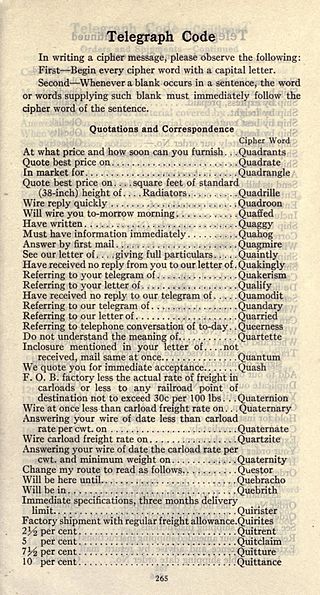In communications and information processing, code is a system of rules to convert information—such as a letter, word, sound, image, or gesture—into another form, sometimes shortened or secret, for communication through a communication channel or storage in a storage medium. An early example is an invention of language, which enabled a person, through speech, to communicate what they thought, saw, heard, or felt to others. But speech limits the range of communication to the distance a voice can carry and limits the audience to those present when the speech is uttered. The invention of writing, which converted spoken language into visual symbols, extended the range of communication across space and time.

Morse code is a telecommunications method which encodes text characters as standardized sequences of two different signal durations, called dots and dashes, or dits and dahs. Morse code is named after Samuel Morse, one of the early developers of the system adopted for electrical telegraphy.
In communication, a code word is an element of a standardized code or protocol. Each code word is assembled in accordance with the specific rules of the code and assigned a unique meaning. Code words are typically used for reasons of reliability, clarity, brevity, or secrecy.
Ten-codes, officially known as ten signals, are brevity codes used to represent common phrases in voice communication, particularly by US public safety officials and in citizens band (CB) radio transmissions. The police version of ten-codes is officially known as the APCO Project 14 Aural Brevity Code.
NB, Nb, or nb may refer to:

Coding theory is the study of the properties of codes and their respective fitness for specific applications. Codes are used for data compression, cryptography, error detection and correction, data transmission and data storage. Codes are studied by various scientific disciplines—such as information theory, electrical engineering, mathematics, linguistics, and computer science—for the purpose of designing efficient and reliable data transmission methods. This typically involves the removal of redundancy and the correction or detection of errors in the transmitted data.

In mathematics and electronics engineering, a binary Golay code is a type of linear error-correcting code used in digital communications. The binary Golay code, along with the ternary Golay code, has a particularly deep and interesting connection to the theory of finite sporadic groups in mathematics. These codes are named in honor of Marcel J. E. Golay whose 1949 paper introducing them has been called, by E. R. Berlekamp, the "best single published page" in coding theory.
Decoding or decode may refer to: is the process of converting code into plain text or any format that is useful for subsequent processes.

PDF417 is a stacked linear barcode format used in a variety of applications such as transport, identification cards, and inventory management. "PDF" stands for Portable Data File. The "417" signifies that each pattern in the code consists of 4 bars and spaces in a pattern that is 17 units (modules) long. The PDF417 symbology was invented by Dr. Ynjiun P. Wang at Symbol Technologies in 1991. It is defined in ISO 15438.

The Aztec Code is a matrix code invented by Andrew Longacre, Jr. and Robert Hussey in 1995. The code was published by AIM, Inc. in 1997. Although the Aztec Code was patented, that patent was officially made public domain. The Aztec Code is also published as ISO/IEC 24778:2008 standard. Named after the resemblance of the central finder pattern to an Aztec pyramid, Aztec Code has the potential to use less space than other matrix barcodes because it does not require a surrounding blank "quiet zone".
A password is a word, phrase or string of characters used to gain access to a resource, such as an object, area or information.

Radio-paging code No. 1 is an asynchronous protocol used to transmit data to pagers. Its usual designation is an acronym of the Post Office Code Standardisation Advisory Group, the name of the group that developed the code under the chairmanship of the British Post Office that used to operate most telecommunications in Britain before privatization.
In mathematics and computer science, in the field of coding theory, the Hamming bound is a limit on the parameters of an arbitrary block code: it is also known as the sphere-packing bound or the volume bound from an interpretation in terms of packing balls in the Hamming metric into the space of all possible words. It gives an important limitation on the efficiency with which any error-correcting code can utilize the space in which its code words are embedded. A code that attains the Hamming bound is said to be a perfect code.

Procedural signs or prosigns are shorthand signals used in Morse code telegraphy, for the purpose of simplifying and standardizing procedural protocols for landline and radio communication. The procedural signs are distinct from conventional Morse code abbreviations, which consist mainly of brevity codes that convey messages to other parties with greater speed and accuracy. However, some codes are used both as prosigns and as single letters or punctuation marks, and for those, the distinction between a prosign and abbreviation is ambiguous, even in context.
Procedure words are words or phrases limited to radiotelephony procedure used to facilitate communication by conveying information in a condensed standard verbal format. Prowords are voice versions of the much older procedural signs for Morse code which were first developed in the 1860s for Morse telegraphy, and their meaning is identical.
In common usage and linguistics, concision is a communication principle of eliminating redundancy, generally achieved by using as few words as possible in a sentence while preserving its meaning. More generally, it is achieved through the omission of parts that impart information that was already given, that is obvious or that is irrelevant. Outside of linguistics, a message may be similarly "dense" in other forms of communication.

In telecommunication, a commercial code is a code once used to save on cablegram costs. Telegraph charged per word sent, so companies which sent large volumes of telegrams developed codes to save money on tolls. Elaborate commercial codes which encoded complete phrases into single words were developed and published as codebooks of thousands of phrases and sentences with corresponding codewords. Commercial codes were not generally intended to keep telegrams private, as codes were widely published; they were usually cost-saving measures only.







